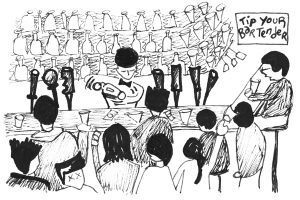Salem Eames, Culture Editor

Proximity
The first key to getting your drink is proximity. In other words, get to the actual bar if at all possible. Sometimes this isn’t possible. Perhaps there is a large Colombian man who grimaces at you every time you accidentally brush his arm, or maybe there is a large American woman who smells like last night’s Chinese takeout. Perhaps there is a tiny French transsexual who won’t stop winking at you. Or a chuckling clown—maybe a circus is in town, and the bearded woman and trapeze swingers make fun of your shoes because one is untied and the laces are covered in red sauce from the pizza slice that you accidentally stepped on at Tino’s. There may be bear traps. (I’ve only seen this once, and it was at The Alley.) The point being, sometimes it isn’t possible to physically get to the bar. In cases like these, get as close as you can. Just kidding. In cases like these, give up. If you can’t make it to the bar after reading this article, you are truly a failure, and dear reader do not take this personally; because if you are a failure at making it up to a bar, you are probably far more successful than the rest of us in enterprises of legitimate value.
The best method for getting your entire body up to the bar is to get each individual part of your body nearer, one at a time. You cannot simply waltz right up (though I’ve seen some tango successfully). You will begin where we all begin: at the back of a cold, huddled mass of bodies–people who are scared, eyeing each other warily; all strangers with grim expressions, waiting for some shred of hope to appear–waiting for an opening to wriggle through, to finally obtain that sweet succor of a crisp, cold, malty and complex beer.
To begin, try getting one arm in between two people who are standing in front of you. If you can’t fit an arm, try for a hand; even a pinky finger is better than nothing! From here, you can slowly advance the rest of your body as the crowd ebbs to and fro. If at any point you can reach between the folks in front of you and physically grasp the bar, you’ve made it. Hold on for dear life. Once those people get their drinks, you simply slide in. Now we proceed to step two.
Eye Contact
Once you’ve made it to the bar, your efforts are all for naught if you stand there like a dead slug and stare at the floor. Make your presence known. Try to achieve eye contact with the bartender. Don’t be creepy about it. Keep it at eye level. Unless you’re already familiar with the bartender or have superhuman pick-up skills, I’m sure she won’t be interested in your advance anyway. Just look at her until you catch her eye and your presence is acknowledged.
Posture
Posture goes hand in hand with eye contact. Have some money ready and visible. Lean forward slightly. Look like you are about to get a drink. Know that you are about to get a drink. Don’t climb on top of the bar and dance like a bonobo to get the bartender’s attention (certain venues aside). Merely use a little bit of posturing to make yourself stand out.
Language
When talking to your bartender, be friendly and respectful. Avoid nicknames. (There is a caveat to this; nicknames are sometimes acceptable if you’re already familiar with the person.) Don’t say “Hey chief.” Likewise, don’t say “bro” or “honey” unless the person in question is in fact your bro or honey. Either use the bartender’s name or use “sir,” “miss,” or “ma’am.” A polite “excuse me…” combined with eye contact is also acceptable. Keep small talk to a minimum unless it is initiated by the bartender. Know what you want before she gets to you. When she arrives, give your order and any pertinent information regarding ingredients or preparation (not applicable in many venues), and be sure to say “thank you.”
Tipping
Tipping should be obvious, but unfortunately stinginess is one of the many social ailments of our generation (stinginess that is often ironically complemented with a bias toward impulsiveness). Leave a tip after every drink and the bartender is certain to remember you better than the next person. If you are paying with cash, tip from your change each round. Don’t save it all up for the end. The bartender will know you are taking care of her and will thus make sure to take care of you. Tipping isn’t extra; it is expected. Only in the direst of circumstances—horrendous service, a freak stabbing, etc.—is it acceptable to withhold tip.
And thus concludes the five tips. Tipping was the final tip, save a tip of the hat, which is to signal that you may now happily repair to The Sip.
(Illustration by Mary Cheung)
Leave a Reply